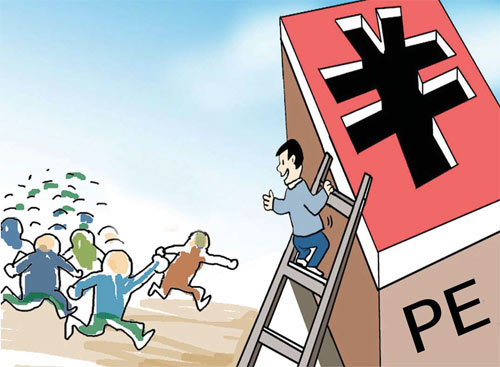New avenues for investment
Updated: 2011-05-13 10:58
By Luca Dell'Anese (China Daily European Weekly)
Chinese private equity and venture capital sectors are setting trends as part of an emerging role
|
 |
China is rapidly becoming one of the global epicenters of the private equity (PE) and venture capital (VC) industries. In fact, as a result of a growing economy, an extremely dynamic private sector, increasingly favorable government policies and spectacular returns in recent years, PE and VC investors from all over the world are flocking to China looking for investment opportunities.
This new role of the Chinese PE and VC industries as global trendsetters is a remarkable development considering that the asset class was almost an unknown quantity in China only a few years ago, and that major institutional investors and PE and VC firms worldwide looked skeptically at emerging markets for a long time, due to the limited investment opportunities, the lack of Western-style regulatory and tax regimes and few exit routes for the investments as a result of the absence of developed merger and acquisition and initial public offering markets in those jurisdictions. The unsatisfactory results of the investments in many China-focused funds in the early 1990s contributed to the cautious attitude.
Such restraint appears to be long gone today. According to data released by Zero2IPO, a Chinese research firm, PE firms investing on the mainland raised $27.62 billion (19.1 billion euros) in 2010, more than twice the amount raised in 2009 and closer to the record fundraising activity registered in 2007 and 2008, before the financial crisis. Analysts expect fundraising to double again in 2011. As far as VC is concerned, 2010 set a new record in fundraising, with more than $11.17 billion of new available funds, up 90 percent from 2009 and more than 50 percent higher than the record amount committed in 2008.
These results are even more remarkable if compared to the less than stellar fundraising activity of PE and VC firms in the world's biggest private equity market, the United States. In fact, despite the improved economic situation and the recovery of the credit markets after the 2008 financial meltdown, capital commitments in the US remained stagnant or declining. And if the capital invested in China by PE and VC firms is still a fraction of what is managed by the asset class in the US, PE and VC in China have additional room for growth, considering that the size of the industry in terms of national GDP is far lower than the one in the US or other developed countries.
Furthermore, new financial resources will flow into the industry in the next few years as a result of recent regulations allowing Chinese insurance companies to allocate as much as 5 percent of their assets to private equity investments and the National Social Security Fund to invest up to 10 percent of its assets into alternative asset classes.
This is good news for these institutional investors - and indirectly their clients and beneficiaries, ordinary Chinese investors - that are now allowed to diversify their portfolios investing in the equity of companies not listed on a stock exchange while chasing the superior returns that private equity has historically offered compared to investments in bonds or stocks of listed companies. This kind of institutional investors, with their long-term approach, are also the most prepared to cope with the risks connected with the illiquidity of the asset class.
China is rapidly developing a favorable ecosystem for PE and VC firms. Last year, the first national private equity "fund of funds", set up by China Development Bank and the Suzhou Venture Group to invest in PE and VC funds, started its operations with $9 billion under management. Domestic exit routes for PE investments have also become more accessible: IPOs on the Shanghai and Shenzhen stock exchanges have boomed, together with Hong Kong, reducing the role traditionally played by the US stock exchanges as the preferred destination for Chinese companies going public.
In particular, the launch in Shenzhen in 2009 of the ChiNext board, a Nasdaq-type stock exchange for high-growth companies, has been an immediate and remarkable success. Finally, over the years a group of domestic PE and VC funds have emerged as leaders in the field: Funds like Legend Capital, New Horizon Capital, CCBI or Hony Capital have become renowned brands in the industry. Even if none of the Chinese funds is yet a global competitor to the major foreign PE houses such as Carlyle, Blackstone, TPG or KKR, they have been able to give the more experienced international firms a run for their money in China, thanks to their superior understanding of the local market and their business connections.
Notwithstanding the improved business environment, many challenges remain for the PE industry in China. First, there is a legitimate concern that the flood of money going into the asset class will not find enough good business opportunities to be deployed, increasing competition for deals and inflating valuations of the target companies. This is the result of the different sizes and structures of the deals carried out in China compared to those put together in the US and Europe. In fact, while the US and European PE markets are focused on multibillion dollar leveraged buyouts, where funds acquire using debt controlling stakes of large and mature firms in need of restructuring and strategic refocus, the Chinese PE market is mostly growth-capital oriented, with capital (mostly equity) invested into minority stakes of profitable, fast growing companies. The deal size in China is growing but rarely exceeds $100 million, with the typical deal in the range of $10-25 million.
Due to the small size of the investments, the ability to deploy large amount of capital will depend on the continuous development in the future of a large pool of fast growing Chinese companies. The current trend of few large international PE houses, such as TPG and Carlyle, that are raising funds destined to investments in western China, seems to anticipate a more competitive and less profitable business environment in the coastal regions, where investments are currently concentrated.
In addition, the current trend of foreign funds to move onshore and raise yuan funds to access the vast pool of capital from Chinese investors and receive more favorable policy and funding support from local governments is a process full of regulatory, legal and tax uncertainties. Even though recent regulatory changes have clarified some of the issues, the regulatory framework is still rudimental in many respects and in need of improvement.
Despite these limitations, PE and VC firms are making a critical contribution to the development of many Chinese companies by providing financial resources to enterprises facing severe difficulties in accessing the capital markets. More than that, PE and VC companies bring critical managerial and financial skills that help fuel the growth of the companies in which they invest. In the current Chinese context, this means first of all an effort to institute clear and formal corporate governance rules in the portfolio companies and make the business fully compliant with Chinese tax and accounting rules, two conditions that are critical steps in order for the company to be considered for an IPO. PE and VC investors also add value to the business by participating actively in its development, usually through their seats in the board of directors, for example by contributing to the development of the company's strategy, its domestic and international expansion and its strategic alliances.
At the operational level, VC and PE investors provide equally critical contributions, using their vast network of professional contacts to provide experienced managers and experts to work in business functions such as manufacturing, finance, the supply chain or human resources.
Finally, PE and VC firms put their financial expertise at the service of the portfolio companies, helping them to raise money effectively and leading them through the complex process to get approval for an IPO, the preferred exit strategy sought after by Chinese companies, in China or overseas. Many of the Chinese companies that went public in the last few years went through a pre-IPO stage of PE investing, with the fund acting both as investor and guide to the company.
The Chinese PE and VC industries seem to have reached a tipping point and become an important component of the Chinese financial system. Much of the future economic success of the country will depend on the ability of the private sector to develop successful and innovative companies. PE and VC will increasingly perform a critical function by providing financial, strategic and managerial resources to the development of the Chinese economy.
The author is professor and associate dean at the international business school of Beijing Foreign Studies University.
E-paper

War of the roses
European Chinese rose growers are beating their Chinese rivals at their own game
Preview of the coming issue
High-tech park gets big boost
At the source
Specials

New wave
Coastal city banks on marine sector to ride next stage of economic development

Drunk driving
Drunk drivers face a detention for one to six months and a revokation of their drivers' license.

V-Day parade
A military parade marking the 66th anniversary of the Soviet victory over Nazi.
